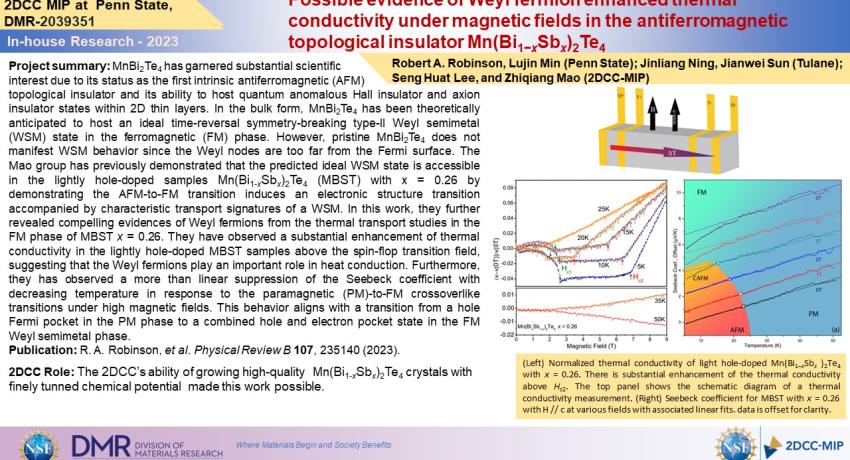MnBi2Te4 has garnered substantial scientific interest due to its status as the first intrinsic antiferromagnetic (AFM) topological insulator and its ability to host quantum anomalous Hall insulator and axion insulator states within 2D thin layers. In the bulk form, MnBi2Te4 has been theoretically anticipated to host an ideal time-reversal symmetry-breaking type-II Weyl semimetal (WSM) state in the ferromagnetic (FM) phase. However, pristine MnBi2Te4 does not manifest WSM behavior since the Weyl nodes are too far from the Fermi surface. The Mao group has previously demonstrated that the predicted ideal WSM state is accessible in the lightly hole-doped samples Mn(Bi1-xSbx)2Te4 (MBST) with x = 0.26 by demonstrating the AFM-to-FM transition induces an electronic structure transition accompanied by characteristic transport signatures of a WSM. In this work, they further revealed compelling evidence of Weyl fermions from the thermal transport studies in the FM phase of MBST x = 0.26. They have observed a substantial enhancement of thermal conductivity in the lightly hole-doped MBST samples above the spin-flop transition field, suggesting that the Weyl fermions play an important role in heat conduction. Furthermore, they have observed a more than linear suppression of the Seebeck coefficient with decreasing temperature in response to the paramagnetic (PM)-to-FM crossoverlike transitions under high magnetic fields. This behavior aligns with a transition from a hole Fermi pocket in the PM phase to a combined hole and electron pocket state in the FM Weyl semimetal phase.
Publication: R. A. Robinson, et al. "Possible evidence of Weyl fermion enhanced thermal conductivity under magnetic fields in the antiferromagnetic topological insulator Mn(Bi1−xSbx)2Te4," Physical Review B 107, 235140 (2023). https://doi.org/10.1103/PhysRevB.107.235140
2DCC Role: The 2DCC’s ability to grow high-quality Mn(Bi1-xSbx)2Te4 crystals with finely tuned chemical potential made this work possible.
What Has Been Achieved: This work revealed further compelling evidence of Weyl fermions from the thermal transport studies on the FM phase of MBST x = 0.26 and demonstrated that Weyl fermions play a critical role in heat conduction.
Importance of Achievement: These findings provided further evidence for the field-driven topological phase transition from an AFM topological insulator to a FM Weyl semimetal in MnBi2Te4, and advanced understanding of topological physics in magnetic topological insulators.
Unique Features of the MIP That Enabled Project: Synthesis of high-quality Mn(Bi1-xSbx)2Te4 single crystals with finely tuned chemical potential is extremely challenging due to the disorders caused by its non-stoichiometry compositions. The 2DCC has developed a protocol to grow Mn(Bi1-xSbx)2Te4 single crystals with good quality that enables this work.
Acknowledgments: This work is primarily supported by the National Science Foundation through the Penn State 2D Crystal Consortium - Materials Innovation Platform (2DCC-MIP) under NSF Cooperative Agreement No. DMR-2039351. Z.Q.M. also acknowledges the support from the U.S. National Science Foundation under Grant No. DMR 2211327. J.W.S. acknowledges the support from the U.S. Department of Energy under Grant No. DE-SC0014208 for the computational work.
